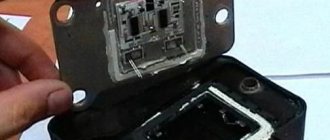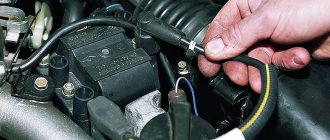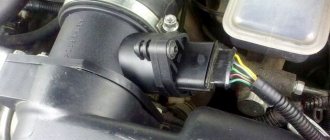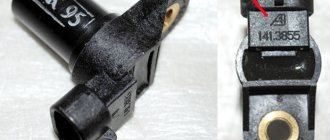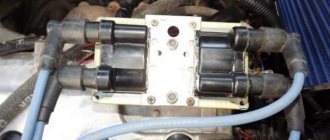The design of any car requires impulse conductors from the ignition system to the fuel combustion system (directly to the spark plugs). They are also found in the VAZ 2114. These are high-voltage (HV) wires. When the impulse does not pass or the discharge has insufficient power, the gasoline in the cylinders does not burn completely, and the engine operates intermittently.
High-voltage wires VAZ 2102
Therefore, it is very important to know what resistance should be on the high-voltage wires of the VAZ 2114, and what needs to be done if it does not meet the standard.
How to check high-voltage (HV) wires and determine their resistance
The main task of high-voltage wires is to transmit a current pulse from the ignition coil to the spark plug.
Timely and guaranteed ignition of the fuel in the cylinder depends on the quality of current transmission, which entails normal, correct operation of the engine.
For various reasons, high-voltage (HV) wires may not conduct at all or conduct only a small part of the current pulse from the ignition to the spark plug.
The main reasons for the malfunction of explosive wires are the following:
- core rupture;
- current leakage (breakdown through insulation);
- resistance is higher than normal;
- poor contact with the spark plug;
- rupture of the conductor.
With faulty explosive wires, the engine runs intermittently and produces extraneous vibrations, because In some cylinder the combustion of the mixture occurs with a delay.
Basic faults
Most VP malfunctions lead to either insufficient current supply to the spark plugs or to its complete absence. This happens for the following reasons:
- current leakage due to insulation damage (as well as through contaminated spark plugs, caps, wires and other elements);
- rupture of the conductor;
- oxidation and contamination of spark plug contacts, ignition coil, metal contact of wire and conductor;
- exceeding the permissible VP resistance.
The cost of VP depends on the materials used and the brand of car for which they are intended. On average, the price varies from 500 to 2000 rubles. For domestic cars - from 400 for “classics” to 1500 for injection 16-valve units.
When purchasing, it is best if the packaging with the wires specifically indicates which engines they are suitable for.
Checking high voltage wires
The first sign of a wire malfunction is the presence of an external spark on the explosive wires. Easy to see in the dark by looking under the hood.
The next method is also best done in the dark: take a piece of wire and strip it on both sides. Next, we connect the wire with one end to ground (battery or car body), and with the other end we run it along the wires at the joints, caps, etc. if there is a leak, a spark will form.
To check the resistance of the wires, we need a multimeter in ohmmeter mode.
In order not to confuse the wires, it is more convenient to check them one by one, i.e. remove the wire from the 1st cylinder and remove the other end of this wire from the ignition module.
- Turn off the ignition.
- Remove one end of the wire from the cylinder.
- Remove the other end of the wire from the ignition module (as in the figure).
- We connect both ends to an ohmmeter and watch the readings.
- We carry out the same operation on all wires.
For serviceable wires, the resistance should vary from 3.5 to 10 kOhm, depending on the manufacturer (written on the wire insulation). And the permissible spread is 2-4 kOhm. If the spread is greater, then the wires need to be replaced ( Replacing VAZ high-voltage wires ).
Which parts to choose?
When choosing spark plugs for a VAZ 2106 car, you must be guided by the numerical value indicated on the marking. It denotes the heat value of the element, which characterizes the candle’s ability to remove heat and self-clean from carbon deposits during operation. According to the Russian classification, elements are divided into the following groups:
If you install too “hot” or “cold” spark plugs on a VAZ 2106 car, the engine will not be able to function in normal mode with maximum efficiency. The letter indices on the marking indicate less important parameters, but they also need to be taken into account. For example, a product with the designation A17DV is suitable for engines with a carburetor and an ignition system with mechanical contacts, and A17DVRM is suitable for power units with an injector.
The trouble is that the classification of imported candles differs from Russian ones, and there is no single measurement system; each manufacturer has its own. Therefore, before you buy reliable products from the Japanese company NGK or another brand for the VAZ 2106, it is recommended to study the table.
| Type of power and ignition system | According to Russian classification | NGK, Japan | Bosch, Germany | Beru, Germany | Brisk, Czech Republic |
| Carburetor, mechanical contacts | A17DV, A17DVM | BP6E | W7D | W7D | L15Y |
| Carburetor, electronic | A17DV-10, A17DVR | BP6E, BP6ES, BPR6E | W7D, WR7DC, WR7DP | 14-7D, 14-7DU, 14R-7DU | L15Y,L15YC, LR15Y |
| Injector, electronic | A17DVRM | BPR6ES | WR7DC | 14R7DU | LR15Y |
Using the table, you can select elements from some foreign brands for classic Zhiguli models with different fuel supply methods and types of sparking systems.
Resistance of high voltage wires
We compare the results of the readings. The permissible spread on the wires is 2-4 kOhm. If more, then the explosive wires need to be replaced. By the way, you need to replace the wires as a set, not one at a time. Each manufacturer has a different high-voltage wire resistance.
Let's look at the most common wires:
- Tesla. Resistance 6 kOhm (fake Tesla 8 kOhm).
- Slon. Resistance from 4 to 7 kOhm (4 on the first and almost 7 on the last).
- ProSport. Resistance is almost 0.
- Cargen. Resistance 0.9 kOhm (each wire has a different resistance due to different lengths, rounded values are shown).
Source
Field repair
If urgent repairs are needed, then after identifying the problem wire, find the damaged area and clean it with a knife. Next, you will need a copper-based connector, which is secured with regular twisting.
Afterwards everything needs to be isolated, which is the main problem. Regular electrical tape requires 8-10 layers for safety, plus moisture forms between the layers during winding.
The method will not return all the power, but it will easily allow you to get to the nearest service station or postpone repair of the ignition system for a couple of days.
Checking high-voltage wires with a multimeter on a VAZ 2114
HF wires (stand for high-voltage) are needed as direct impulse conductors from the ignition device to the fuel ignition system (directly to the spark plugs). If the pulse does not flow or does not flow properly, the gasoline will not burn properly in the cylinder and the engine will not operate as it should.
High-voltage wires VAZ 2114
Naturally, high-voltage wiring tends to fail. Signs of malfunction of high-voltage wires may be the following:
- The wiring is broken
- The wiring is broken, current is flowing past
- On the contrary, the wiring has heated up, the resistance is higher than normal
- The fine conductive vein has ruptured
At the same time, with all this, the engine will definitely shake and twitch. By the way, if you look under the hood and see how the wires sparkle when the ignition is on, then this is a direct guide to replacing the wires!
How the wires are arranged
The wiring structure is the same as that of the electrical wiring in the apartment. A large number of copper wires are combined into a core. On top of the core there is a core and an insulator. The outer insulating layer usually consists of a silicone, polyethylene, polyvinyl chloride, rubber shell. The additional shell protects against the destructive effects of fuels and lubricants.
High-voltage wires VAZ 2114
What are the signs of faulty high-voltage wires:
- Broken wiring.
- Leakage current.
- Warming up wiring.
- Rupture of current-carrying conductors and insulation.
Broken wiring
If the wiring is faulty, the engine will stall and stall. If you find sparking wiring under the hood, it must be replaced immediately.
Wiring characteristics
In this case, a basic skill is required on how to check high-voltage wires with a multimeter. By the way, you can probably check in another way, but this is the most correct and logical. But for now let’s talk about something else, even if you realized that the explosive wires of the VAZ 2114 are dead, in any case, you will have to buy new ones.
As it turned out, high-voltage workers have their own GOST number - 14867-79. These numbers indicate the quality of the wires - that they are high-voltage. Also, on domestic wiring there is a brand - PPOV: polyethylene wire, irradiated, with a polyvinyl chloride sheath.
Signs
You shouldn’t go to the ignition system wires for every internal combustion engine problem, because they are only responsible for it. More specifically, their zone of influence is associated with arson of the fuel mixture, so the symptoms are:
- problematic engine starting (especially in the rain);
- “glitches” of electrical appliances, for example, radio tape recorders;
- floating idle speed;
- jerky acceleration;
- reduction in engine power;
- increased fuel consumption.
But, most of the symptoms can be caused by wear of the spark plugs, so we will check the armored wires with visual inspections and various instruments (multimeter and oscilloscope).
Visual inspection
You may find external damage, but the best way is to start the engine at night. Then the breakdown will give itself away with a spark, especially if the engine compartment is very wet, but you should not water the engine.
Additional wire
You can also find the breakdown location with an additional copper wire. Take the wire, strip its edges, and twist some of them into a half ring. Then connect one part to the body, and move it in a semi-ring along each armored wire. You will also see sparking at the breakdown site. In this case, you can wet the wires a little, but only a little.
Screwdriver
This method will reveal the very fact of penetration, but not its exact location. The task is to wind several turns on a long screwdriver and touch the cylinder head block with its end. Sparking will confirm the fact of the malfunction.
Disconnecting wires
Start the engine and disconnect the spark plug wires one at a time while observing engine operation. If the motor operation does not change when disconnected, then this wire is faulty and must be replaced.
This method is not suitable for everyone, since the wires are not publicly available everywhere. Basically, this access is provided to carburetor internal combustion engines, but some injection engines, for example, AvtoVAZ, also have this feature.
The absence of a spark does not necessarily mean that it is in good condition; it is not necessarily a matter of complete breakdown. Also, remember to wear insulating gloves to prevent electric shock.
Wiring check
Checking high-voltage ignition wires begins with a simple diagnosis, because all of the above symptoms of problems may indicate a breakdown of other parts of the engine system or something else. For a simple check it is better to wait until dark. Then you need to expose a small section of the wire on one side and the other and close one end to the body of the car or battery, and the second is needed for maneuver: we move it along the wiring joints, plugs, and so on. When there is a hole there will be a spark immediately. The result is obvious - replacement is required. But this method is primary; it concerns direct current leakage, which is not always the reason for the non-operating state of high-voltage devices. In the case of voltage, such a number will not work.
To measure it, you need to know what resistance the high-voltage wires should have. After all, each wire from a specific manufacturer has its own resistance, technical characteristics and dimensions:
1) Tesla - 6 kOhm, it is often counterfeited, then you can squeeze out as much as 8 kOhm
3) ProSport tends to zero
Checking high-voltage ignition wires with a multimeter
For measuring work, you need a simple multimeter, which we switch to ohmmeter mode. We measure one wire at a time, removing one by one from the cylinders from left to right and from the coil itself. The procedure is simple:
- make sure the car is turned off
- remove the end of the wire from the fastener on the cylinder
- remove the opposite end from the ignition coil mounting
- you need to connect both ends to the multimeter
- read the readings
- write them down so as not to forget
- We do this three more times with the remaining wires
Normal resistance is numbers in the range from 3.4 to 9.8 kOhm. Of course, all this depends on the manufacturer; this parameter is printed on the rubber skin of the wire. If you have a difference with the permissible value, which varies from 2 to 4 kOhm, this is normal. But no more! If more, then the wires are not suitable for driving, they need to be changed.
We always replace wires as a set! Even if one has fallen into disrepair, and the rest are in good technical condition.
That's basically it. Now you should replace the old wires with the purchased new ones.
Source
Members of the resistance - magazine Behind the Wheel
It starts poorly, jerks, does not pull... Very often, such engine ailments are treated by simply replacing high-voltage wires. The nature of the phenomenon is clear - we have written about it more than once. As is known, the spark energy depends on many parameters, including the power of the high-voltage pulse that reaches the electrodes of the spark plug. In other words, from losses in the ignition line. In a carburetor engine, the “science”, in general, ends there, but in an injection engine the influence of the control system is added. Indeed, if the combustion intensity is insufficient or if flares are missed, the feedback will work through the control system, increasing the fuel supply - to compensate for the supposedly excess oxygen. This will affect both gasoline consumption and especially the toxicity of exhaust gases. And if so, then each high-voltage wire actually becomes part of the engine control system!
Hence the purpose of our examination: analysis of the influence of various high-voltage wires on the main indicators of a real VAZ-2112 engine. As usual, everything was purchased from large metropolitan auto stores. We took two sets of wires from ten different companies - domestic and foreign. They took two for a reason - in order to prevent possible accusations of bias. Like, you can’t judge by one example! Let's not argue - it's better to change the verification procedure.
A laboratory ohmmeter was used to determine the resistance of each wire - all 80 of them. Then they measured the length of the wires, divided one by the other and got the linear resistance - in kilo-ohms per meter. Logically, for the same sets there should not be a large spread - the cable is cut from the same reel. But…
This happened in all sets from eight companies. But at Caesar in two wires it jumped almost an order of magnitude compared to the other six. Master Sport repeated the same picture, albeit for one wire. Little things? Maybe. But so that they do not distort the overall picture, we selected test kits for these brands so that the wires had approximately equal linear resistance, not without reason assuming that they would be quite standard. To compensate for the trouble, they allowed themselves to mutter that the manufacturer should have taken care of this.
From brand to brand, resistance varies by almost three orders of magnitude - from tens of ohms (for the Pro.Sport kit) to almost ten kOhms (for the Master Sport kit). Is this important for the motor? Let's find out.
For testing, we took spark plugs with a minimum resistance of the noise suppression resistor - we settled on Bosch Platin FR7DPX. At the same time, out of twenty candles, four were chosen with almost the same resistance - 3.2 kOhm. The spark plugs, of course, are in good working order - they were rechecked beforehand.
With each set of wires, the engine had to work out the so-called universal test cycle - with driving both in the city and on the highway. Its power, instantaneous fuel consumption and exhaust gas toxicity were measured. And out of love for art, they organized another test - they checked the uniform operation of individual cylinders. To do this, having brought the engine to a certain mode, the fuel supply to the cylinders was turned off one by one. Then, by simple subtraction, the indicator torque of each cylinder was determined and compared.
How to check and replace high-voltage ignition wires on a VAZ 2114
High-voltage ignition wires of the VAZ 2114 are part of the ignition system, through which an electrical impulse is transmitted from the module to the spark plugs. When the current hits the spark plugs, the fuel mixture ignites in the combustion cylinders, which gives rise to a new stroke of the engine.
The design of the GDP, unlike conventional wires, is quite complex. In addition to the conductive core (which is made of copper) and protective insulation, they have metal tips and plastic protective caps.
What to pay attention to
First, check the wires for visible damage - melting and insulation damage. Rapid failure of wires can occur in the following situations: Vibration. The cause of wire failure may be engine vibration, which leads to loosening of the electrical contacts of the spark plugs. At the same time, the voltage supplied to the spark plugs increases. An increase in voltage can damage not only high-voltage wires, but also ignition coils.
High temperatures. Heat from the engine can melt insulation and wire lugs. A damaged tip disrupts the fixation of the wire and affects the operation of the corresponding spark plug. Damage to the insulation can lead to grounding of the wire to metal parts of the body, and there will be no sparking in the cylinder.
Abrasive impact. When high-voltage wires begin to touch engine parts (especially those with sharp edges), damage and breakage of the wires occurs. If this happens, there is a risk of the wire being grounded to the body.
Equipment Required: Digital Multimeter
Set the digital multimeter to measure resistance (Ohms, ?). Hold the tester's pins on both ends of the wire and determine its resistance. The Society of Automotive Engineers (SAE) has set the upper limit of the resistance value at 3,600 ohm-m. However, car manufacturers may recommend different values, so it is best to consult your vehicle's repair manual for reference.
Required equipment: 12-volt phase indicator
Connect the indicator to ground. Start the engine and run the indicator along all the wires. The appearance of a spark indicates damage to the wire insulation and the need to replace it.
Note
When checking for shorted wires, try to avoid contact with metal parts in the engine compartment.
High-voltage ignition wires VAZ 2114 - device
It is important to know: The efficiency of ignition of the mixture directly depends on the quality of the high-voltage wires, which means stable engine operation in different modes.
The classic model of the ignition system for all cars around the world provides for a set of five high-voltage carriers. The central cable supplies high voltage from the ignition coil to the distribution device - distributor. Next, four cables supply voltage to the spark plugs.
Modern cars use an electronic ignition system. The circuit does not change, but additional cables may be added if the flammable liquid is ignited by two spark plugs in each combustion chamber.
- conductive copper, graphite or non-conductive twisted conductors;
- ferroplast shell - insulator;
- metal wire screen;
- sealing hard shell;
- tips on both sides.
Classification by conductor type
According to the type of conductor, spark plug wires can be:
- With copper conductor. Such cables are considered classic and have a very low resistance - about 0.2 Ohm/m. The main disadvantage is the significant level of interference that occurs during the operation of the ignition system.
- With conductor made of non-metallic material. Structurally, such a wire is made of linen thread, Kevlar, fiberglass with graphite impregnation. In this case, the core is enclosed in a special shell made of electrically conductive plastic. The distributed resistance is about 2 kOhm/m. Such cables should only be used with interference suppression devices.
- With a non-metallic conductive core, they are structurally made almost identically to the wire described above. A distinctive feature is a higher distributed resistance - about 40 kOhm/m. Such cables can be used without interference suppression devices.
Signs of faulty armored wires of the VAZ 2114
The main signs of a malfunction of the VAZ 2114 armored wires are:
- Difficulty starting the engine;
- Unstable operation of the engine in idle mode;
- Increased hydrocarbon content in emissions;
- Radio interference, which can lead to malfunction of the multimedia system, electronic control unit and other devices
Therefore, in order to avoid lowering your ranking in search engines, a link to the source is required.
As a rule, when there is severe wear on the wire insulation, many microcracks appear, due to which current leakage occurs. As a result, the wire is not able to transmit to the spark plug a current that is sufficient in magnitude for its normal operation. This significantly increases the spark generation time and interferes with the correct operation of the engine cylinders.
Location of the ignition module of the old VAZ 2114
Quite often there are cases when wires are damaged as a result of contact with any engine elements. Situations of loss of cap tightness are also possible, and as a result - oxidation of contacts and current leakage. Regular cleaning of contacts is a mandatory procedure, especially when operating a vehicle in difficult climatic conditions.
Classification by insulation material
As mentioned above, spark plug wires are classified depending on the material from which the insulation is made. In budget cables, the insulation is most often made of polyvinyl chloride material. Such insulation can withstand temperatures ranging from -20 to +120 degrees.
Insulation made from the so-called elastomer is considered to be of higher quality. The main distinctive feature of cables with such insulation is their high resistance to the negative effects of chemically aggressive substances. The temperature range at which the elastomer does not lose its qualities lies within -30 - +180 degrees.
Silicone insulated cable has the highest characteristics. Silicone insulation can withstand temperatures ranging from -50 to +250 degrees and has the greatest durability compared to other types of insulation. It is wires with such insulation that are recommended by many automakers, including domestic ones.
Checking high-voltage ignition wires with a multimeter on a VAZ 2114 - step-by-step instructions
Checking high-voltage ignition wires begins with a simple diagnosis, because all of the above symptoms of problems may indicate a breakdown of other parts of the engine system or something else. For a simple check it is better to wait until dark. Then you need to expose a small section of the wire on one side and the other and close one end to the body of the car or battery, and the second is needed for maneuver: we move it along the wiring joints, plugs, and so on. When there is a hole there will be a spark immediately. The result is obvious - replacement is required. But this method is primary; it concerns direct current leakage, which is not always the reason for the non-operating state of high-voltage devices. In the case of voltage, such a number will not work.
Checking the resistance of armored wires of a VAZ 2114 with a multimeter
To measure it, you need to know what resistance the high-voltage wires should have. After all, each wire from a specific manufacturer has its own resistance, technical characteristics and dimensions:
1) Tesla - 6 kOhm, it is often counterfeited, then you can squeeze out as much as 8 kOhm
3) ProSport tends to zero
For measuring work, you need a simple multimeter, which we switch to ohmmeter mode. We measure one wire at a time, removing one by one from the cylinders from left to right and from the coil itself.
To check the high-voltage ignition wires on a VAZ 2114, you must do the following:
- Make sure the car is turned off
- Remove the end of the wire from the fastener on the cylinder
- Remove the opposite end from the ignition coil mounting
- You need to connect both ends to the multimeter
- Reading the readings
- Write them down so you don't forget
- We do this three more times with the remaining wires.
How to check the wiring if there are no obvious signs of damage, but the engine malfunctions
If this method of checking does not live up to expectations, test the wiring with a voltmeter. How to check high-voltage wires on a VAZ 2114?
Signs of direct damage are easiest to spot after dark. It is necessary to strip the wiring sections from opposite sides and short-circuit one side to the housing or battery. With the other side we move along the plugs, wiring contacts and other conductors. If there is a breakdown, a spark will appear.
The voltmeter is switched to ohmmeter mode. Measure all the wires, sequentially removing them from the cylinders and coils from left to right. Each indicator must be recorded, so prepare paper and pen (pencil) in advance.
Features of choosing VVPZ for VAZ 2114
When choosing a GDP for a VAZ, it is necessary to take into account two key factors - their resistance and breakdown voltage. The lower the resistance, the better the electrical impulse will be transmitted, and the magnitude of the maximum breakdown voltage determines how resistant the high-voltage wires on the VAZ 2114 will be to breakdowns.
The resistance value of products from different manufacturers differs from each other. As an example, we give you the resistance of the most popular types of GDP:
| Manufacturer | Resistance on cylinder No. 1 (kOhm) | Resistance on cylinder No. 2 | Resistance on cylinder No. 3 | Resistance on cylinder No. 4 | Breakdown voltage (kV) |
| Tesla | 3.27 | 4.16 | 5.02 | 6.26 | 50 |
| Cezar | 3.1 | 3.53 | 4.23 | 5.34 | 50 |
| Finwhale | 1.95 | 2.18 | 2.6 | 3.42 | 50 |
| Ween | 6.17 | 6.57 | 7.52 | 9.89 | 35 |
| Slon | 4.24 | 4.74 | 5.19 | 7.6 | 50 |
Expert opinion: The products of the Czech company Tesla receive the largest number of positive reviews from the owners of the fourteenth. Their wires have optimal resistance and high breakdown voltage, and at the same time they are truly made to last - they do not tan or crack.
The cost of the Tesla GDP set is about 500 rubles, Cezar – 450 rubles, Ween – 270 rubles, Finwhale – 600 rubles, Slon – 500 rubles.
Carburetor Feature
On a carburetor engine, you can unscrew the spark plug and place it on the cylinder head together with the armored wire. Next, crank the crankshaft a little with the starter and watch for a spark. The engine is a mass, so a strong spark must be produced. If there is little or no spark, then the problem is in the wire.
But, the method will work if all the candles are in excellent condition. After checking, you can additionally inspect the wire visually or “pierce” it with a multimeter.
We also recommend that owners of carburetor internal combustion engines initially check the central high-voltage wire going to the distributor. This will help identify the problem if the engine does not start or the power has dropped very much. Perhaps the central one does not supply enough voltage to the others through the distributor.
A similar procedure cannot be carried out with an injection engine, because the electronic switch and engine control unit will fail.
Replacement and connection of high-voltage ignition wires of a VAZ 2114
Important to know: Incorrect installation and location of high-voltage wires can lead to sparks jumping from wire to wire or to ground, which, in turn, can lead to misfires and a decrease in the crankshaft speed when the car is moving at high speed.
The order of connecting high-voltage wires must be strictly sequential, since each cylinder of the engine corresponds to a specific socket on the ignition module. Considering that there is a numbering of the sockets on the ignition module body, the risk of confusing anything is minimal.
Connecting armored wires to the ignition module of a VAZ 2114
The procedure for connecting high-voltage wires of the VAZ 2114 injection type depends on the year of manufacture of your car. Fourteen cars before 2004 had 4-pin ignition modules installed, and cars after 2004 had 3-pin coils.
Recommendations for replacement
Before you start replacing VAZ 2106 spark plugs, you need to make sure that the gap between the electrodes in the new parts is 0.7-0.8 mm for cam ignition systems and 0.8-0.9 mm for electronic ones. The gap is measured with a flat feeler gauge; in spark plugs with several side electrodes - with a round one.
The replacement algorithm is as follows:
- Turn off the ignition and remove the high-voltage wires from the spark plugs, holding them by the tips.
- Unscrew the old parts and clean the seats with a brush.
- Screw in new spark plugs, tighten them with medium force.
- Connect the wires and start the engine.
When connecting high-voltage wires, it is important not to mix them up, so you need to follow the markings on the distributor cover.
Service life of high-voltage ignition wires on VAZ family cars
According to the recommendations of Auto VAZ, replacement of high-voltage wires of the VAZ 2114 should be done every 30 thousand kilometers. In practice, motorists rarely comply with these replacement deadlines, since if the wires do not have any mechanical damage, they can travel about 100-150 thousand km.
Numbering of connection of armored wires to the ignition module of VAZ 2114
When the service life is exceeded, the internal resistance of the GDP increases, which negatively affects the transmission of the electrical impulse. This leads to problems with ignition and acceleration dynamics, since when the supply of current to the spark plugs is delayed, the normal engine operating cycle is disrupted.
Source
Reasons for replacing elements
The spark plug in any car must function in difficult conditions, solving the following problems:
- promptly ignite the air-fuel mixture compressed in the cylinder;
- provide an even and powerful spark discharge on its contacts;
- sparking should not deteriorate under any engine operating mode.
For ignorant car enthusiasts, checking spark plugs comes down to a “spark” test. This gives rise to an erroneous statement: if, when connected to a source, a spark jumps between the contacts, then the element is in good working order.
But the conditions inside the combustion chamber differ from normal atmospheric ones, since there is high pressure (over 10 Bar), and instead of air there is fuel plus high temperature. Often, a spark plug that produces a reliable spark discharge in air, in the cylinder, works with misfires or does not spark at all.
The operability of the elements can only be determined on a stand with high voltage applied and pressure created in the chamber. Such a check is not available to most ordinary motorists; the only way out is to promptly replace the VAZ 2106 spark plugs by purchasing high-quality products from well-known manufacturers. These include famous brands NGK, Bosch, Beru and Brisk.
Russian spark plugs of the A17 series cannot boast of a long service life and fail after 15-20 thousand kilometers, as evidenced by the following signs:
- The engine "troits". Moreover, sometimes it is impossible to understand which cylinder is failing, since all 4 spark plugs skip ignition cycles.
- The car performs poorly and is unstable until it warms up.
- With high fuel consumption, a drop in power is observed.
- A particularly bad case is when the oil pressure light comes on. This is the result of long-term driving on bad spark plugs, when the fuel that does not burn in the cylinders flows into the crankcase and dilutes the oil, causing its pressure to drop.
Every car enthusiast should remember that if the power unit malfunctions, the first step is to unscrew the spark plugs and visually check their condition.
The color and thickness of carbon deposits on the contacts can tell a lot to an understanding motorist:
- black carbon deposits on the contacts indicate that the fuel in the chamber does not burn completely, perhaps the spark plug has failed;
- a white coating on the electrodes indicates a poor air-fuel mixture, the spark plug is working;
- red carbon deposits indicate that the fuel contains harmful additives; the spark plug is most likely in good working order;
- thick “fluffy” carbon deposits are the result of combustion of oil entering the chamber through the seals or piston group.
The damaged wire has been found. Now what?
If the check shows that the current-carrying wire is broken, but the insulation of the high-voltage wire is intact, then the most reasonable option is to purchase a new wire. If the wire core is intact and only the insulation is damaged, then you can use electrical tape (this is important if the damage is discovered on the road). But you need to understand that duct tape is only a temporary measure to get you home. After this, the car owner will still have to go to the store for new wires.
As can be seen from the article, even a novice car enthusiast can check the serviceability of high-voltage wires, since there is nothing complicated about it. The main thing is to be patient, have a high-quality multimeter and know the rated resistance of the high-voltage wires in your car.



